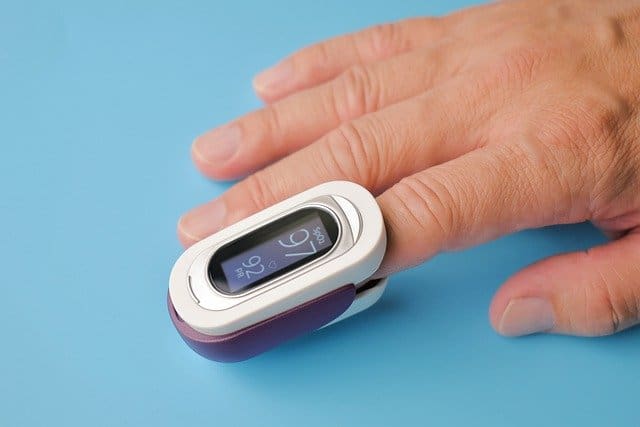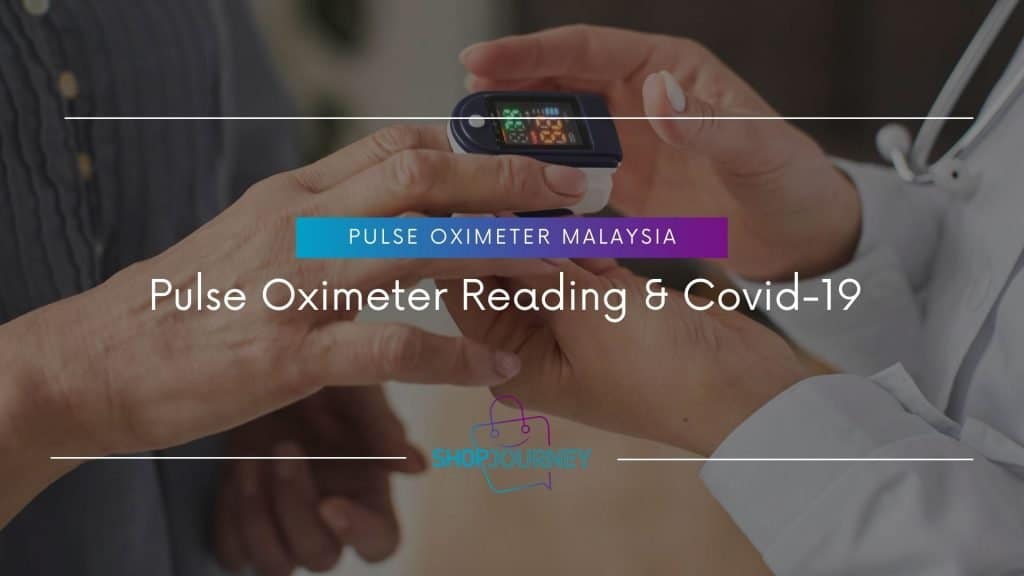Have you heard of the pulse oximeter? Do you know how to use it? Do you think owning one is just a baseless trend or of life-saving importance during the Covid-19 pandemic?
Previously a commonly used but relatively unknown medical device to most individuals not in the healthcare field, a pulse oximeter was not the most likely item you would expect in a first aid kit, that was until the Covid-19 pandemic began.
A pulse oximeter is a non-invasive device used to assess the concentration of oxygen in a patient’s blood. As most people know, infection with the Covid-19 virus is said to cause a rapid and potentially life-threatening drop in oxygen levels within the blood. Therefore, owning this device may help you distinguish between a harmless cold and a deadly case of Covid-19.
Thus, the surge in popularity of this device is understandable as people try to gain a sense of control over an unseen yet ever-present threat like a pandemic. Therefore, let’s take a look at the pulse oximeter function, how to decipher the pulse oximeter reading, different pulse oximeter brands, and pulse oximeter prices.
What is a Pulse Oximeter?
Pulse oximetry involves the use of a non-invasive medical device (meaning it does not involve puncturing the skin, using blood drawn from an artery, or physically entering the body) known as a pulse oximeter to estimate the amount of oxygen within your blood. It looks like a small device that is placed on the fingertip in a clip-like fashion, typically on the thumb or middle finger of your dominant hand.
Pulse oximetry works by passing particular wavelengths of light through your finger, a red light, and an infrared light. Then a monitoring device on the other side of the device measures the amount of light transmitted through your finger (ie the amount of light that was not absorbed).
The amount of light transmitted is heavily influenced by the concentration of oxygen within your blood, which is then interpreted by the device as the percentage of hemoglobin molecules (the oxygen-carrying molecule of the body) within the red blood cells that are fully saturated with oxygen (known as SpO2).
The device is commonly used in hospitals, emergency rooms, or nursing homes. However, it is becoming a common feature of an increasing number of first-aid kits due to the rise of the global Covid-19 pandemic.
Pulse oximeters readings are quite accurate and the device is safe, effective, and can be used by all age groups. The fact that the device is a non-invasive test for measuring the oxygen saturation level of a patient is another great advantage, unlike arterial blood gas (ABG) measurement which requires collecting a blood sample from an artery. While an ABG test may be more accurate, an oximeter reading is quicker and causes no discomfort.
Using An Oximeter to Measure Oxygen Saturation
Now that we know what pulse oximetry is, let’s take a closer look at exactly how the device is used, how it works, and the factors that may influence the accuracy of its readings.
How Does a Pulse Oximeter Measure Blood Oxygen Levels?
One side of the device possesses two light-emitting diodes (LEDs) which give off light at specific wavelengths. One which gives off infrared light and another which produces red light. These light rays then pass through your fingertip and are measured by a monitoring device located at the other end of the oximeter.
Blood absorbs different amounts of light depending on the level of oxygen. Therefore, by measuring the amount of light transmitted through the skin and by extension the amount of light absorbed by the blood, an estimate of the concentration of oxygen within the blood can be given.
The concentration of oxygen within the blood is typically expressed as a percentage known as saturation of peripheral oxygen (SpO2). This is a measure of the percentage of hemoglobin within the blood that is fully saturated with oxygen molecules. This and more will be discussed more deeply later in the article.
How Do You Use A Pulse Oximeter?
One of the advantages of this device over other ways of measuring a person’s oxygen levels is the fact that it is quite easy to use. Simply place the device over a translucent (semi-transparent) part of the body and wait a few seconds for the reading to display.
Typically the device is placed on the thumb or middle finger of the dominant hand, but it can also be placed on the ear lobe or even the toes in infants. Another advantage of the device is that it is easy to read and can be read by the wearer.
What Factors Can Affect the Accuracy of a Pulse Oximeter Reading?
Several factors have been known to affect the accuracy of the device to varying degrees. Some of which include:
- The part of the body used for measurement. Research has shown that the thumb and middle finger of the dominant hand provide the most accurate measurements.
- The temperature of the body part used may also affect the accuracy of the reading. Warming your hands before using the device gives a more accurate estimate.
- Poor peripheral circulation is another important factor that may affect the accuracy of the device.
- Thick skin, for example, due to calluses or obesity, can also affect the value of the reading obtained.
- Studies have shown that the oxygen saturation value measured while sitting in an upright position is significantly higher than that measured when lying down.
Other things that can affect the accuracy of a pulse oximeter reading include anemia, hypotension, carbon monoxide poisoning, certain types of hemoglobin variants, cyanide poisoning, and so on.
Pulse Oximeter Reading
Okay, we’ve taken a look at what a pulse oximeter is, how it works, and the factors that can affect the accuracy of your blood oxygen level readings. Let’s take a look at how you can interpret pulse oximeter readings and the sort of information the device can provide.
The first thing you have to know is that reading a basic oximeter is not rocket science. The device was designed so that even someone who is not a health care provider can quickly get the most basic information from the display and be alerted of any dangers immediately.

So what type of information can you get from this device? A pulse oximeter provides the user with basically two sets of readings; the person’s oxygen levels (measured in SpO2) and their heart rate (measured in beats per minute). Let’s take a closer look at both parameters.
- Oxygen levels: A pulse oximeter provides a close approximation of the oxygen levels within the blood by measuring the saturation of peripheral oxygen (SpO2). SpO2 is a measure of the percentage of hemoglobin within the red blood cells that is fully saturated with oxygen. Normal levels of oxygen typically range between 95% to 100% in most individuals.
- Heart rate: A pulse oximeter is also a great way to monitor your heart rate, i.e. the number of times the heart pumps blood in one minute, usually expressed in beats per minute (bpm). A heart rate between 60 to 100 bpm is considered normal in most individuals.
Abnormalities in any of these readings could be caused by a wide range of conditions. For example, a lung or heart condition such as Covid-19 has been known to cause a drop in SpO2 below normal and may also affect your heart rate. Therefore, if you notice an abnormal reading on your pulse oximeter contact a health care provider immediately to provide medical advice.
Can an Oximeter Help Detect COVID-19?
An oximeter may provide one of the first signs of a Covid-19 infection. It is possible for your blood oxygen levels to drop even before you start noticing symptoms such as cough or shortness of breath. Therefore, keeping a close eye on your oxygen levels is a smart idea.
How Does Covid-19 Affect Oxygen Levels?
Covid-19 is an inflammatory lung condition and like most conditions affecting the respiratory tree, it can lead to low oxygen levels by impairing lung function. However, this is a summary of the whole process. Let’s take a deeper look at how Covid-19 leads to reduced oxygen levels within the body.
While new research has shown that Covid-19 is a multi-systemic disease and affects more than just your lungs, respiratory symptoms seem to be a common theme among the disease. The virus typically spreads from person to person through close contact. It can be transmitted through respiratory droplets which are exhaled when a person is talking, coughing, sneezing or even breathing.

When these virus-laden droplets enter the respiratory system of another individual the virus quickly enters the cells of the respiratory tract. The virus uses the body’s protein-building structures to produce new viruses and quickly infects other adjacent cells.
This leads to an inflammatory response within the lungs as the body struggles to fight off these foreign intruders. In mild to moderate cases this may manifest as a dry cough or a sore throat, but in more severe cases this inflammatory reaction can quickly lead to your lungs being filled up with fluid, mucus, and cells.
This collection of fluid and debris clogs up the lungs and makes it harder for oxygen to diffuse from the air spaces within the lungs into the blood. This manifests as a drop in peripheral oxygen saturation or SpO2 on your pulse oximeter readings and may even lead to permanent scarring of the lung tissue.
Is Purchasing a Pulse Oximeter a Good Idea?
Purchasing a pulse oximeter is certainly a great idea, especially for individuals who are at risk of developing more severe forms of Covid-19. This includes elderly people, obese individuals, people with a chronic lung and heart condition, diabetes mellitus, sickle cell anemia, sleep apnea, asthma, and so on.
Monitoring your pulse oximeter readings daily may provide you with an early warning sign of a Covid-19 infection. In individuals who have already contracted the virus, monitoring your blood oxygen levels can also help you monitor the progress of the disease and determine when a mild case of Covid-19 may be turning into something potentially more serious.
Where to Get an Oximeter
Let’s take a look at some of the best pulse oximeter Malaysia brands and products you can purchase online. They include:
BioCare Finger Pulse Oximeter
The BioCare Finger Pulse Oximeter is a great option when it comes to monitoring your oxygen levels at home. It has several great features like an 8 hour sleep monitoring time which allows for continuous monitoring of how much oxygen is in the blood throughout the night and an easy-to-read display with a large, self-illuminated OLED blue and yellow dual color display, six modes, and four directions.
It runs on 2 AAA 1.5V batteries. The SpO2 range and accuracy are 70%~100% ± 2%, heart rate range and accuracy are 25~250BMP ± 1BMP, and a blood perfusion index of ≥ 0.2% ~ ±0.1%, which covers the normal values for a healthy individual. The product also comes with a generous 1-year warranty.
Yonker & Yongrow Finger Clip Pulse Oximeter
The Yonker & Yongrow Finger Clip Pulse Oximeter offers 6 hours of continuous monitoring, a low power indicator, and a double color OLED display, which has four directions with six different display modes. In the absence of signals for 8 seconds, the product will be power-off automatically.
The device was made sturdy for individuals who are interested in measuring their SpO2 and pulse rate while on the move such as sports enthusiasts. It also includes a lanyard and carrying case. It runs on 2 AAA 1.5V batteries. The SpO2 range is 70%~99% and heart rate range is 30~240 BMP, which covers the normal values for a healthy individual.
Helcare Pulse Oximeter
This oximeter Malaysia is one of the best on the market. It offers users a large OLED display, a sturdy design that’s great for outdoor enthusiasts, and an easy-to-read display. The product also comes in three popular colors and was made with a universal design to accommodate a wide range of finger sizes.
It runs on 2 AAA 1.5V batteries. The SpO2 range and accuracy are 70%~100% ± 2%, heart rate range and accuracy are 25~250BMP ± 1BMP and an operating temperature of 5°C to 40°C.
Conclusion
Pulse oximeters are important medical devices that utilize special technology to estimate your blood oxygen saturation and heart rate. This is especially important for at-risk populations where early warning signs such as a drop in SpO2 could mean the difference between life and death.
For individuals who want to keep a close eye on their blood oxygen levels, the BioCare Finger Pulse Oximeter is one of the best pulse oximeter brands available and offers a wide range of functions. We recommend that you use a pulse oximeter and don’t forget to drop your comments and questions because we want to hear your opinions on the topic. A pulse oximeter is definitely a vital first-aid tool during the Covid-19 pandemic and an essential component of any first-aid kit.
Frequently Asked Questions
1. What does PI mean on my oximeter?
PI stands for perfusion index. This index measures the ratio of the pulsatile blood flow to the non-pulsatile static flow of blood in the peripheral tissue. The PI’s values range from 0.02% for a very weak pulse to 20% for an extremely strong pulse. Since this varies widely from individual to individual, it is a good idea for each individual to determine their perfusion index.
2. Can stress cause low oxygen levels?
Acute stress can cause a fall in oxygen levels, especially among individuals who have some form of anxiety disorder. When the body senses a stressful situation, it may react by tensing up and taking short, shallow breaths which lead to a slight drop in oxygen levels. The brain interprets this drop in oxygen as another stressor, leading to a vicious positive feedback cycle of increased stress and falling blood oxygen levels.
3. How do you increase oxygen saturation levels?
Chronically low oxygen saturation levels may be worrying but there are several ways to safely increase or maintain your oxygen levels at the comfort of your home. These include activities such as:
- Performing slow and deep breathing exercises
- Consume more antioxidants or a vitamin C supplement
- Staying well hydrated
- Laying down in a prone position
- Including aerobic exercises into your routine
4. What are the symptoms of not having enough oxygen in the blood?
Even though a wide range of conditions can cause a drop in oxygen saturation, low levels of oxygen in the blood usually present similarly. Some common symptoms include:
- Shortness of breath
- Dizziness
- Chest pain
- Headaches
- Restlessness
- Rapid breathing
- Confusion
- High blood pressure




